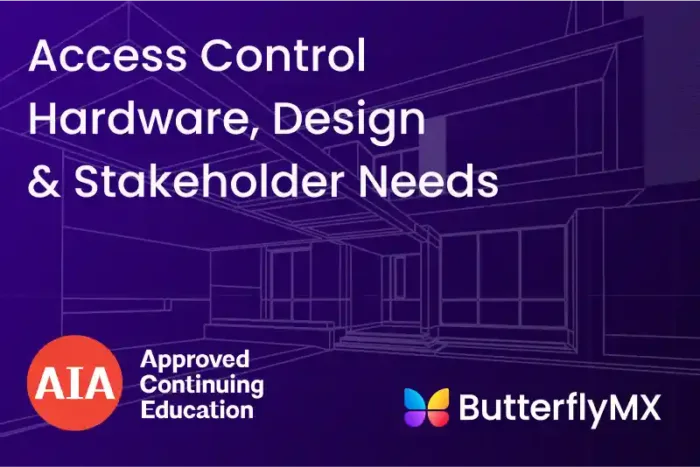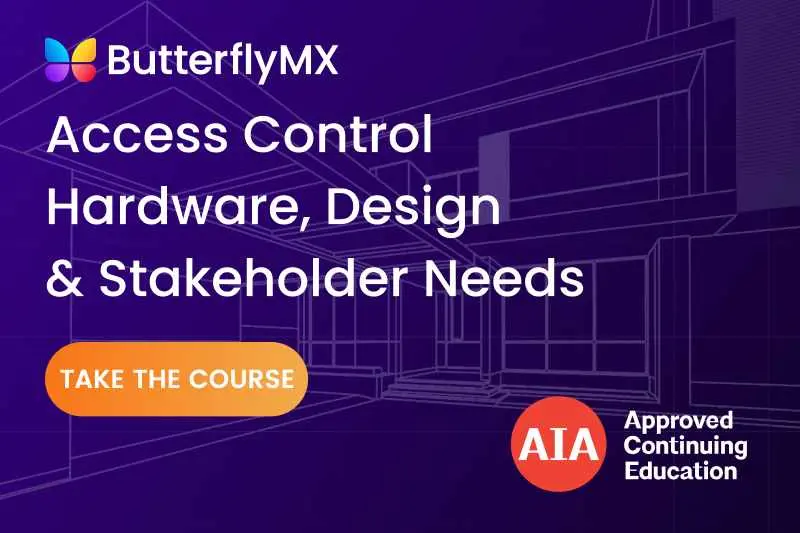
ButterflyMX is excited to announce the availability of our online AIA CES-registered course, “Access Control Hardware, Design & Stakeholder Needs,” which provides architects with 1 elective LU credit in just 40 minutes!
In conjunction with the American Institute of Architects, we’ve created an engaging and easy-to-follow course that helps architects understand how property developers, owners, and managers review, select, and use access control hardware and software.
Start the AIA-approved course to receive your 1 elective LU credit, or read on to discover what the course covers and its benefits.
Navigate this page:
- Course information
- What does this AIA continuing education course cover?
- Why take this course?
- What is AIA continuing education?
- Benefits of AIA membership
Course information
AIA-approved continuing education course title: Access Control Hardware, Design & Stakeholder Needs
Provider #: 10060214
Course #: BMX10124
Credits: 1 Elective LU
What does this AIA continuing education course cover?
“Access Control Hardware, Design & Stakeholder Needs” goes over crucial access control concepts and helps architects better understand their clients’ security and access needs. It also counts as one Elective LU to fulfill AIA’s yearly learning education requirements.
Access Control Hardware, Design & Stakeholder Needs covers the following learning objectives:
- Building standards and codes having to do with access control
- The differences between different access control models and when to use them
- Access control installation in both new developments and retrofits
- Stakeholder needs in terms of access control
Building standards and codes having to do with access control
We review standards that apply nationwide, like the International Fire Code and the International Building Code, and cover how access control hardware must react in case of emergencies.
The differences between different access control models and when to use them
There are four main types of access control models:
- Discretionary
- Mandatory
- Role-based
- Attribute-based
Discover the specific features that make each unique and the key questions you must ask when choosing an access control model for your property.
Access control installation in both new developments and retrofits
As an architect, you aren’t always going to be dealing with new developments. In some cases, you might be hired to help retrofit an existing building — and that means dealing with that building’s existing access control system, as well.
We explore how modern access control hardware makes retrofitting outdated access control systems simple and inexpensive.
Stakeholder needs in terms of access control
Access control needs vary depending on the type of building: residential, commercial, or mixed-use. This course covers the different stakeholder needs in each of these buildings.
What’s more, we also cover the relationship between delivery personnel and access control measures to help you identify the easiest and simplest way to provide access and security.
Why take this course?
By taking our course, you do more than just fulfill your requirements — you gain a unique insight into a unique aspect of building management and security that you might not have considered previously — access control.
As leaders in the access control field, we’re uniquely positioned to give architects insight into what property owners and managers want.
And as access control hardware transitions from analog brass keys and locks to more sophisticated, electronic options, your clients are sure to have questions and concerns that we can help you address.
What is AIA continuing education?
AIA, or the American Institute of Architects, requires licensed architects to earn continuing education (CE) credits in order to maintain membership. They measure these credits in Learning Units (LUs). The number of credits needed to maintain membership varies based on membership and state.
For example, in California, AIA members must complete 10 credits per year. On the other hand, in Kansas, members must complete 30 hours per year.
In order to enhance the learning experience for their members, AIA partners with providers, like ButterflyMX, to provide unique, engaging, and educational courses to their members.
Benefits of AIA membership
So, we’ve spoken about our AIA-approved course “Access Control Hardware, Design & Stakeholder Needs” and about American Institute of Architects continuing education, but what are the benefits of becoming an AIA member?
Benefits of an AIA membership include, but aren’t limited to:
- Connections through your local AIA chapter
- AIA designation
- Discounts on products and services
- Access to the AIA trust
- Government advocacy







